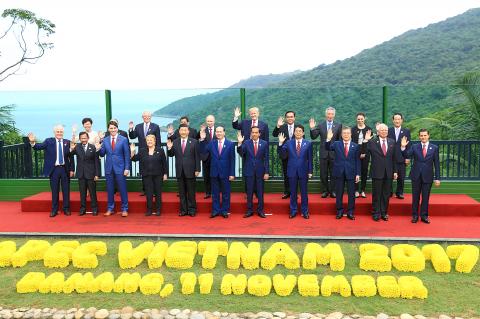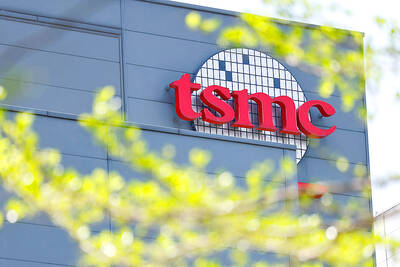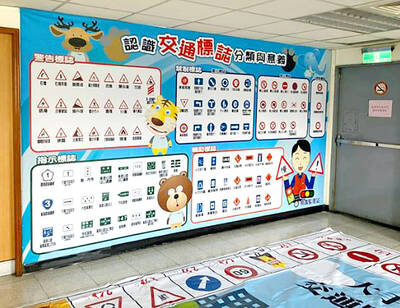A blockbuster Pacific trade pact abandoned by US President Donald Trump has edged closer to becoming reality after days of tense talks in Vietnam.
Japanese Minister of the Economy Toshimitsu Motegi said the 11 remaining members of the Trans-Pacific Partnership (TPP) have secured a framework agreement on how to salvage the deal.
Canada, which held out for a day on signing onto the agreement, said it had won some desired concessions while adding that work is needed to reach a full deal.

Photo: AFP
Motegi spoke to reporters in Da Nang late on Friday, after ministers held another meeting and confirmed the content of the broad agreement, which includes sections to be suspended after the US withdrawal earlier this year.
“We reconfirmed the agreement from yesterday [Thursday], including all the details of the wording used,” Motegi said.
“There’s no mistake,” he said, referring to initial claims from Japan on Thursday that a deal had been struck that were disputed by other countries, causing confusion. “No changes were made to the text.”
Canadian Minister of International Trade Francois-Philippe Champagne defended the delay, saying he had refused to be rushed into an agreement on what he now called the “Comprehensive Progressive TPP.”
The frictions in talks — which saw the Vietnamese trade negotiator walk out late on Thursday night in frustration — had raised concerns that the deal might collapse.
“What we’ve been able to achieve is to preserve market access in Japan, we’ve been able to improve the progressive elements and we’ve also been able to suspend key sections like intellectual property which our Canadian stakeholders thought would have an impact on innovation,” Champagne said.
“We made progress, but we clearly identified the things we still need to work on,” he said. “We have a framework that has been established, so in the sense that we know the elements that people wanted to preserve.”
The TPP, which would have covered 40 percent of the global economy, was thrown into disarray when Trump withdrew the US in one of his first acts as president due to a perceived risk to US jobs, leaving other countries scrambling to keep the deal alive.
The TPP was seen as a hallmark of US engagement with Asia under the prior administration and a buffer against China’s rising clout.
Meanwhile, Liu Meng-chun (劉孟俊), an economist at Taiwan’s Chung-Hua Institution for Economic Research (中華經濟研究院), yesterday said the nation must find a way to join the TPP, and that it must avoid becoming marginalized while also seeking to strengthen its trade relationship with the US.
With the withdrawal of the US, Japan is to take over its leadership role within the TPP, he said, adding that it remains to be seen whether Japan can convince other TPP members to allow Taiwan to be part of the agreement.
Liu said he hopes that Taiwan’s Representative to Japan Frank Hsieh (謝長廷) can speed up efforts to join the agreement.
Vietnam, where several Taiwanese business interests are concentrated, is a TPP member, which could add leverage to Taiwan’s bid for membership, Liu added.
Additional reporting by CNA

EUROPEAN TARGETS: The planned Munich center would support TSMC’s European customers to design high-performance, energy-efficient chips, an executive said Taiwan Semiconductor Manufacturing Co (TSMC, 台積電), the world’s largest contract chipmaker, yesterday said that it plans to launch a new research-and-development (R&D) center in Munich, Germany, next quarter to assist customers with chip design. TSMC Europe president Paul de Bot made the announcement during a technology symposium in Amsterdam on Tuesday, the chipmaker said. The new Munich center would be the firm’s first chip designing center in Europe, it said. The chipmaker has set up a major R&D center at its base of operations in Hsinchu and plans to create a new one in the US to provide services for major US customers,

The Ministry of Transportation and Communications yesterday said that it would redesign the written portion of the driver’s license exam to make it more rigorous. “We hope that the exam can assess drivers’ understanding of traffic rules, particularly those who take the driver’s license test for the first time. In the past, drivers only needed to cram a book of test questions to pass the written exam,” Minister of Transportation and Communications Chen Shih-kai (陳世凱) told a news conference at the Taoyuan Motor Vehicle Office. “In the future, they would not be able to pass the test unless they study traffic regulations

GAINING STEAM: The scheme initially failed to gather much attention, with only 188 cards issued in its first year, but gained popularity amid the COVID-19 pandemic Applications for the Employment Gold Card have increased in the past few years, with the card having been issued to a total of 13,191 people from 101 countries since its introduction in 2018, the National Development Council (NDC) said yesterday. Those who have received the card have included celebrities, such as former NBA star Dwight Howard and Australian-South Korean cheerleader Dahye Lee, the NDC said. The four-in-one Employment Gold Card combines a work permit, resident visa, Alien Resident Certificate (ARC) and re-entry permit. It was first introduced in February 2018 through the Act Governing Recruitment and Employment of Foreign Professionals (外國專業人才延攬及雇用法),

‘A SURVIVAL QUESTION’: US officials have been urging the opposition KMT and TPP not to block defense spending, especially the special defense budget, an official said The US plans to ramp up weapons sales to Taiwan to a level exceeding US President Donald Trump’s first term as part of an effort to deter China as it intensifies military pressure on the nation, two US officials said on condition of anonymity. If US arms sales do accelerate, it could ease worries about the extent of Trump’s commitment to Taiwan. It would also add new friction to the tense US-China relationship. The officials said they expect US approvals for weapons sales to Taiwan over the next four years to surpass those in Trump’s first term, with one of them saying